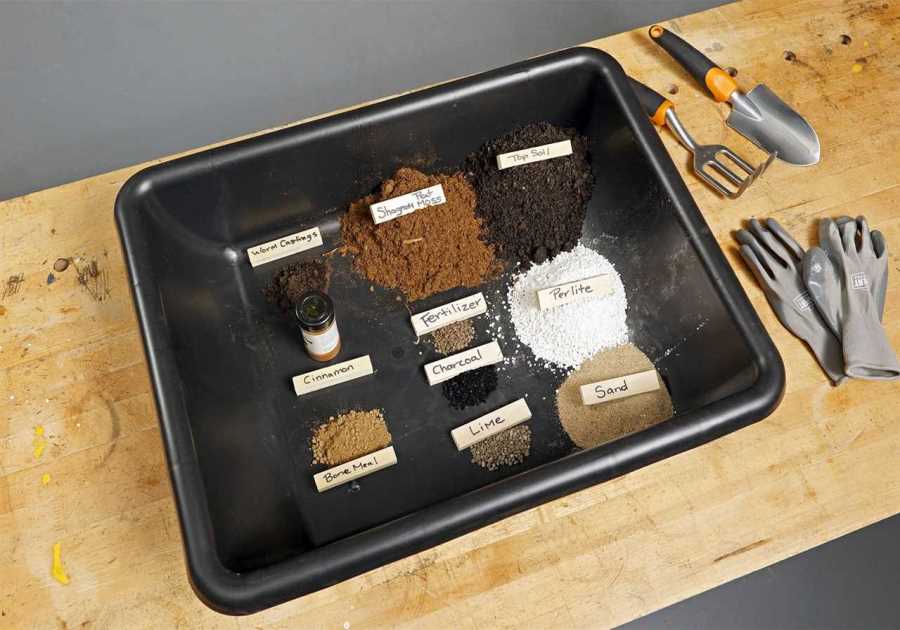With more than 70 breweries, there's no question Seattle is a beer center, but these local spots are leading the craft beer scene in a refreshing new direction.
Seattle and beer go way back. Within three years of becoming a city in 1851, the place had a brewery. That original one—Washington Brewery—is long gone, but according to an old newspaper ad, it was a solid spot for porter and cream ale. It's since spawned a beer empire.
Seattle’s connection to beer makes sense. The city has great natural water sources from nearby mountains and is in close proximity to some of the world's finest hop fields in the Yakima Valley.
Not only is the Emerald City a standout spot to make beer, it's also a great place to drink it. There's nothing better than a cold can of quality craft brew after a day spent exploring the area's famous lakes, mountains, and trails. And when the city's equally famous gray and rain roll in, what better way to brighten the day than over your favorite new ale with fellow beer-loving friends?
Interestingly, the two brands most associated with Seattle aren’t really here anymore. Rainier (represented by that iconic ‘R’ you can't miss when entering town) hasn’t been brewed since 1999, while OG craft brewery Redhook’s presence is greatly diminished. This doesn’t mean that beer is disappearing from Seattle. In fact, it’s stronger than ever, with over 70 breweries calling the city home. In particular, the Ballard Brewery District has become an epicenter for brewing that draws residents and visitors alike.
Related: 50 Best Craft Beers in America
Men's Journal had the chance to chat with local brewers and owners at four different breweries across the city who have different perspectives on the Seattle beer scene. Here's their hot take.
Seattle Breweries That Are Redefining the Local Beer Scene
1. Métier Brewing Company
Métier means “one's calling, one's destiny,” says CEO and co-founder Rodney Hines—and, as we talk, it sounds like the perfect word to describe what led him to open a brewery in Seattle’s Central District, his longtime home.
In 2019, the Brewer’s Association reported less than 1 percent of the country’s craft breweries are Black-owned. With more than 9,000 craft breweries in the U.S., that’s a large gap.
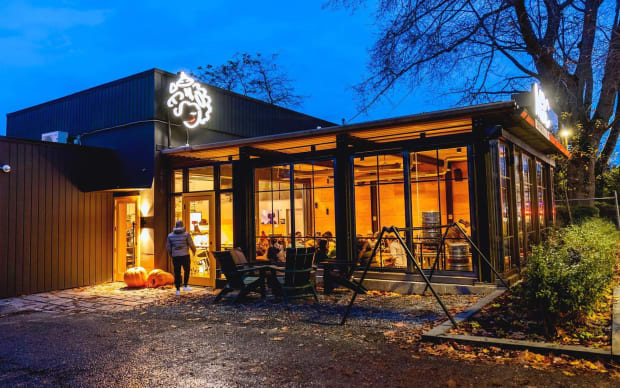
Courtesy image
Hines came from the corporate world, but always loved beer and brewing. He spent time in London, where he gained an appreciation for English pubs. Frequenting craft breweries in the States, he often found he was the only person of color.
“Maybe Black folks don’t like good beer,” someone once suggested to him.
“That’s bullshit,” Hines replied. “We just don’t see ourselves here.”
So Hines started to build his dream, while also acknowledging that it was not something everyone could do: “All of us can dream, but for many of us there’s been a ceiling.”
Related: What's Behind Asheville, North Carolina's Huge Success as a Craft Beer Hub? You'll Have to Visit to Find Out
When he was about to open the first Métier taproom in Woodinville, about 45 minutes outside of Seattle, Hines finally called his oldest brother to tell him what he was doing. He'd worried what his family would think about him opening a brewery.
“It’s about damn time,” his sibling told him.
It wasn’t long before Hines was drawn by his own intentions and the prodding of friends to open a second brewery in the Central District, a historically Black neighborhood in Seattle, where Hines called home. Decades of gentrification have changed CD, but recently projects like Africatown Plaza and the redevelopment of 23rd and Union have given hope to retaining the neighborhood's Black history.
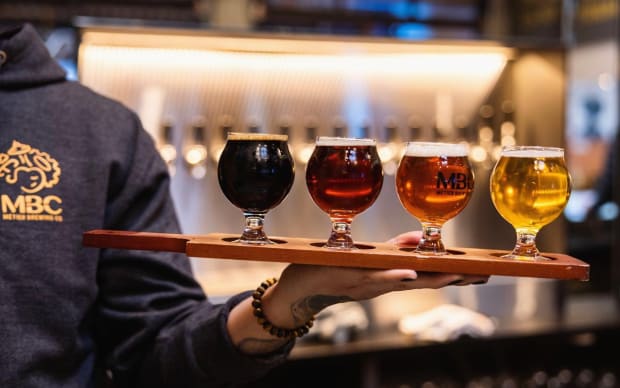
Courtesy image
“I’m invested in CD,” Hines says. “You need to be in the community you embrace.”
His intent was to create a space where people of color could see themselves, both in large photos throughout the space, but also pouring, serving, and brewing beer. And, importantly, drinking it. On that first day at the Central District taproom, Hines says the community came together in a line that stretched around the corner. What's his ultimate goal for the brewery? It's painted right on the wall: “Our mission is to brew damn good beer and build stronger community to inspire bigger dreams for all.”
Related: Brewers Embracing Resilient Grains Amidst Climate Change
Now, Hines says, when you come into Métier you see what Seattle looks like.
When asked about future plans, Hines talks about the recently opened Steelheads Alley. In partnership with the Seattle Mariners, Métier is opening a brewpub right across from T-Mobile Park. Named after the Seattle Steelheads of the West Coast Negro Baseball League dating back to the 1940s, the brewpub honors both local and national players. Métier will be able to increase their brewing capacity—and offer a great spot to grab a beer before and after a game.
“We need to be part of the change for this industry,” Hines says. “What I want to become is a model demonstrating how to be profitable and valuable in your local community.”
Standout Beer: The brewery's award-winning Black Stripe Coconut Porter was inspired by Seattle's Jerk Shack. Proceeds from Métier Pale Ale go to the Major Taylor Project that empowers youth from diverse communities through cycling.
Métier also does some really interesting things with barrel aging. While many breweries age beer in bourbon barrels, Métier has utilized tequila and Laphroaig barrels. Right now, the brewery is perfecting its take on a black Manhattan using rye whiskey.
2. Georgetown Brewing Company
Enter any bar in the Seattle area and you’re likely to see a Georgetown tap handle. Owners Manny Chao and Roger Bialous opened Georgetown just over 20 years ago in 2002. Today, it's grown into not only the city's largest brewery, but the entire beer-crazy state of Washington's—producing just under 120,000 barrels in 2022. The production forecast for 2023 is even bigger.
We had the opportunity to speak to Georgetown's Research & Development Brewer Matt Edwards. Edwards actually got his degree in English education, but when he came to Western Washington, he couldn’t find a job in his field. When he considered the alternatives, brewing seemed like a good one. Edwards asked his wife, who was in medical school, about going to work in a brewery. Her response: “Yeah, go for it. We’re gonna be dirt poor anyway.”
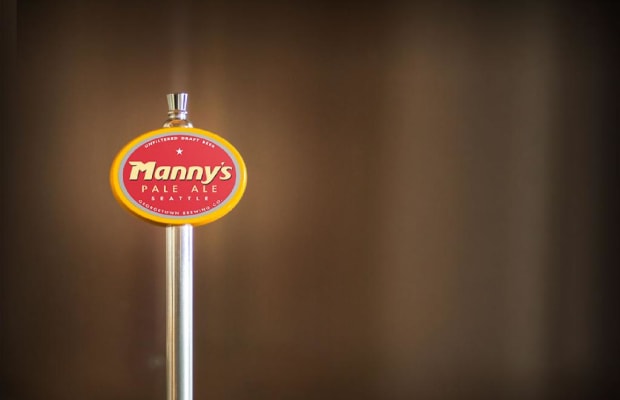
Courtesy image
Edwards got his first job at Redmond’s Mac and Jack’s Brewing Company, happy to start from the bottom and work his way up. "If you’ve got a mop, I’ll push it," was his attitude. When he decided to move on, he visited Georgetown to ask about work. There was nothing, but before he drove off, Chao tapped on his window and told Edwards to call him in a week.
In the 12 years since then, Edwards has moved up through the ranks to the position he now holds. In his role, he helped develop Bodhizafa, one of Georgetown’s most popular beers, as well as the gold medal winner in the American-Style India Pale Ale category at the 2016 Great American Beer Festival. The name of the beer (with a slight spelling alteration due to an errant Google search) originates from Patrick Swayze’s character in the movie Point Break.
Related: Best Beers You Should Be Drinking Now
Bodhizafa is part of a solid core of Georgetown beers. While Edwards and his crew are always working on creating new recipes, the brewery’s regular lineup is also a work in progress. The brewery is constantly updating recipes in a process that Edwards calls “tightening the screws.” As far as the brewery is concerned, there's “not a lot of room for complacency.”
This continual evolution and "screw tightening," notes Edwards, has a lot to do with availability and variability of quality ingredients. If a primary ingredient—say, a certain hop–changes for any given reason, it’s not as if they can just grab the next one. The same strains of hops from Washington can taste different in Oregon, explains Edwards. "Heck, hops from different sides of a valley can bring different characteristics," he says.
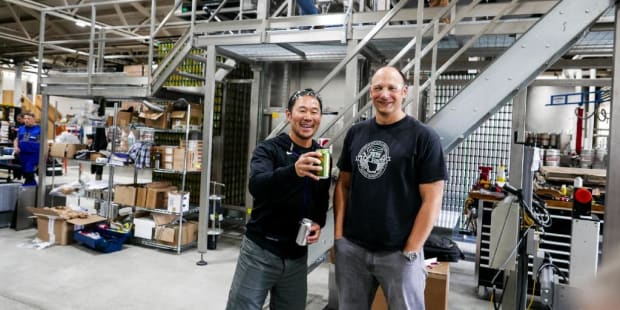
Courtesy image
When nailing down a recipe, Edwards and his team work with the brewery’s sensory team, doing blind testing to make sure they're moving in the right direction. If a beer is working well, they then open the testing to everyone at the brewery. The more voices, the better. Feedback both from the tasting panel and customers is huge, and Edwards says the brewery embraces the criticism. As he says, there can be occasions when the feedback is “not exactly what we want to hear, but what we need to hear.”
Most importantly, he says, “We want to make beer that we want to drink.”
As the biggest brewery in town, Georgetown espouses a relationship with other Seattle breweries that feels “more like neighbors than competitors” says Edwards, who's both given and received assistance on online forums, whether it’s simply providing advice or procuring a missing ingredient. Edwards says that connecting with other brewers has only been a positive: “The better we take care of each other, the better we do as an industry.”
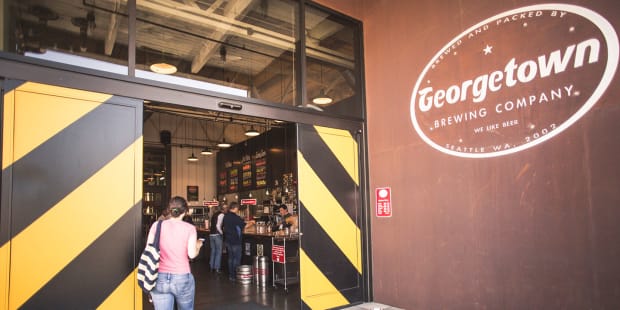
Courtesy image
Standout Beer: Georgetown has a heavyweight core line-up of beers that you'll find throughout the Seattle area. There are beers named after the owners (Manny’s Pale Ale; Roger’s Pilsner) as well as the main characters in Point Break (Bodhi as well as Johnny Utah Pale Ale).
Before he owned the largest brewery in Washington State, Manny Chao was a counselor at a camp for kids with cancer. It was there that he connected with Charles “Bob” Hirsch, who had battled leukemia throughout his childhood. Chao connected with Hirsch and even went up to Juneau, AK, to celebrate his 21st birthday. Sadly, Hirsch died that same year.
When Hirsch’s brother asked Georgetown to name a beer after his brother, the brewery was happy to do it. But co-owners Chao and Bialous wanted to do more. Since 2005, every year on Hirsch’s birthday (May 14), Georgetown releases Bob’s Brown Ale, with 100 percent of the proceeds going to Ronald McDonald House Charities of Western Washington & Alaska. Not only does the beer celebrate the memory of Bob Hirsch, its sales have helped raise more than a million dollars for charity.
3. Lucky Envelope Brewing
The idea of opening a brewery was hatched at Barry Chan’s house—where he was home brewing—while Raymond Kwan was on the couch.
“I was playing video games,” Kwan says.
At the time, Kwan was looking for a new business opportunity, and Chan was frustrated with his job as a structural engineer. The problem? He was promoted.
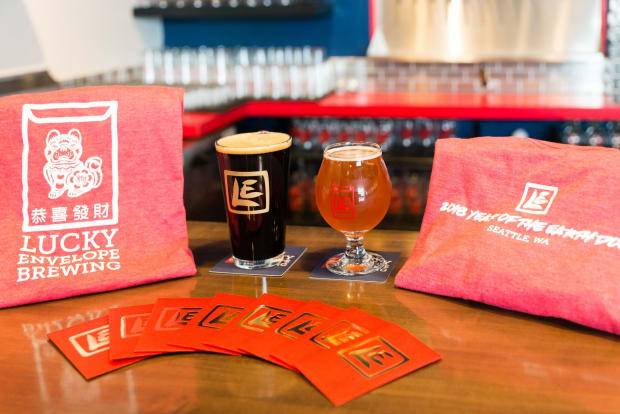
Courtesy image
“Managing was not what I wanted to do,” says Chan. So, on his lunch hours, Chan would visit Seattle’s Central Library—and specifically a long shelf of brewing books, which he quickly devoured. Then he went home to make beer. After entering his beer in contests and cobbling up wins, he decided he was ready for something bigger.
At first, Kwan (from New Jersey) and Chan (Pennsylvania), envisioned an East Coast-style sports bar. Due to “money and experience and the lack thereof," as Kwan puts it, they decided to focus on a brewery alone. Choosing a location in Ballard, a Seattle neighborhood that was already becoming the destination for breweries—"which we viewed as a positive," says Kwan—they launched Lucky Envelope.
Related: Most Scenic Breweries in America to Enjoy Beers With a View
Open since 2015, Kwan says Lucky Envelope’s brewing philosophy has always been to create culturally inspired beer. The name comes from a Chinese tradition of handing out red envelopes filled with paper money. According to the brewery, “The color red is meant to ward off evil spirits and bring good health, while the money inside is supposed to bring prosperity.”
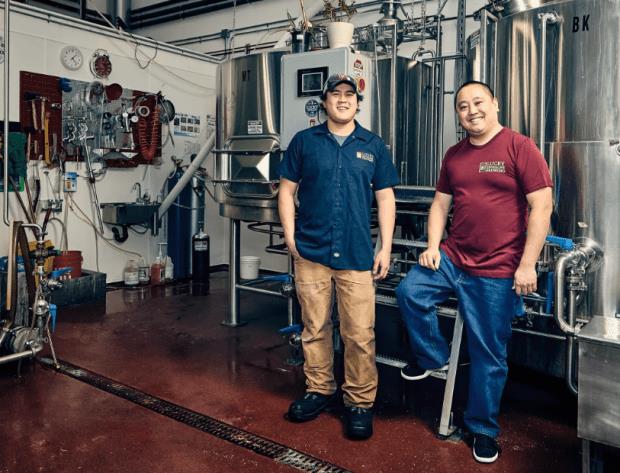
Courtesy image
Even with the name, Kwan says their original logo—featuring a picture of hops—didn’t represent the owners’ Chinese-American background. When they opened, they didn’t want to be thought of as only a Chinese brewery.
“We wanted people to focus on the beer,” Chan says.
The owners still talk about a pivotal moment when a local came in a year after they'd opened and told them he absolutely loved their beer. He also confessed that due to his own admitted ignorance he'd been avoiding the “weird Asian brewery.” It wasn’t long after this that Lucky Envelope rebranded to celebrate their heritage.
Only 2 percent of U.S. craft breweries are Asian-owned. Lucky Envelope has always embraced a culturally inspired philosophy to creating beer—from their Belgian Trippel with Thai lime leaves and lemongrass to Metal Ox, a collaboration beer recently made for Chinese New Year with Asheville’s Highland Brewing, another Asian-owned brewery.
Lucky Envelope isn't just looking to Asian cultures for beer inspiration. True to its Ballard roots, the crew launched Gotlandsdricka beer, based on Swedish home brew, made with juniper boughs and smoked malts.
“We pay a lot of respect to modern brewing culture, and we also want to have a little fun—and pull inspiration from all over the world,“ says Chan.
As for his brewing philosophy, Chan says, “You’ve got to take your licks and not be afraid to bruise your ego. I’m talking beer-wise. A failing company? I’m totally afraid of that.”
As for the future, Chan and Kwan have discussed a second taproom—but it doesn’t necessarily need to be in Seattle, or even in the U.S.
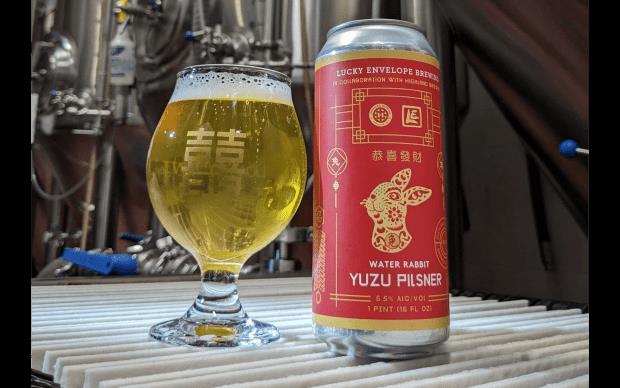
Courtesy image
Standout Beer: Lucky Envelope always has something interesting in cans or on tap. There's the award-winning Peanut Butter Cream Stout, as well as the Helles Lager that took home a Great American Beer Festival silver in 2015.
One of the most fascinating beers Lucky Envelope makes is Mijiaya Historic Chinese Beer, which has roots in an archeological dig in China’s Shannxi province. Scientists found an ancient brewery–more than 5,000 years old–along with amphorae that included a yellow residue of beer. Chan was curious and contacted the archaeologists about their findings. In return, the scientists sent him a list of everything they found. As Chan started translating from the scientific names, he realized he recognized many, if not all of them. For example, the archaeologists found coiv lacryma-jobi, commonly known as Job’s tears—an ingredient his mother used in soup. Other ingredients in the beer he made with the recipe include barley, millet, lily flowers, and yam. The result is a beer—inspired by a five-millennia-old sample—that’s bright and flowery.
4. Future Primitive
Co-founders Ian Roberts and Dean Hudgins were in the beer business—selling it—years before they started a brewery. They own a bar named the Pine Box located inside a former mortuary in the Capitol Hill neighborhood. But as they made more and more connections in the Seattle beer world, starting their own brewery became a natural draw. "It was just something we always wanted to do," says Roberts.
Eventually, they found a spot in White Center, a neighborhood fondly known as “Rat City.” According to a Washington state history site, the name may have come from the neighborhood being home to a Reserve Army Training Center during World War II, or perhaps because it was a Restricted Alcohol Territory. Either way, the building they found had always been a brewery, but it wasn’t in great shape, including at least one wall that was just hung from the ceiling. Roberts and Hudgins got busy revitalizing it and adding all new equipment.
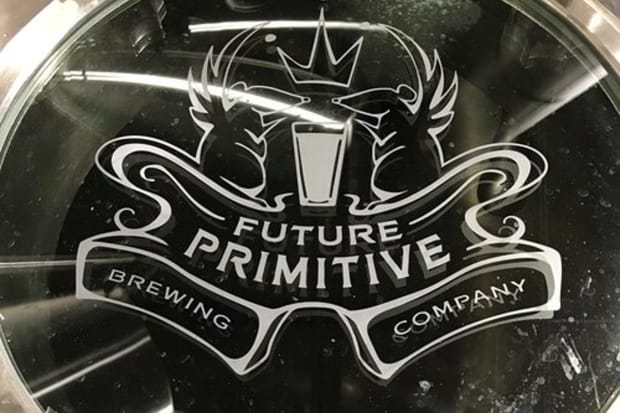
The brewery’s name comes from the title of a 1985 skateboarding video from Powell Peralta. And if you visit this brewery just across the Seattle city line, you’ll see some skateboard decks lining the walls. You’ll also find there’s a meaning to the name existing outside of skating. When head brewer Kevin Watson first heard the name, he thought it was perfect—“pushing boundaries while being rooted in tradition.” Watson explains that beer, at its core, is a very primitive beverage, “It’s still a medieval practice, no matter how you look at it.”
As for the medieval beer they were making, Watson, who previously brewed at Elysian and Maine’s Allagash, says there was a plan: “We wanted to focus on American ales, German lagers, and Belgian ales.”
I ask Roberts if there’s a philosophy behind Future Primitive: His response: “We can say what we think, anytime we want.”
Related: Earth Day is Every Day for the Best Eco-Conscious Craft Breweries in America
One of the ways that Future Primitive expresses its viewpoint is through its beer names. If there’s a subject that matters to the brewery, it’s easy to figure out Future Primitive’s stance when you pick up a can of Nazi Punks Fuck Off—a nod to the Dead Kennedys' song—or Her Body, Her Choice. If someone doesn’t agree, Roberts says, “We welcome backlash.”
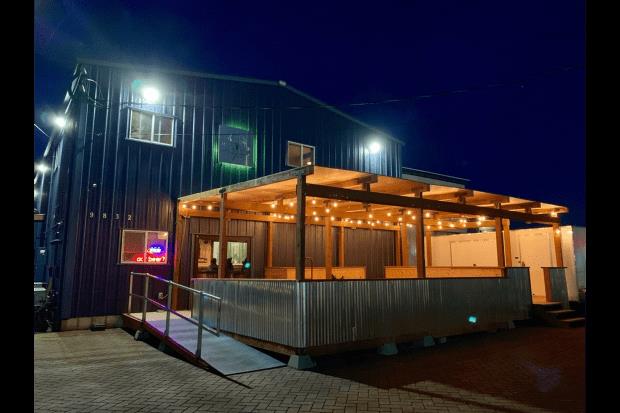
Courtesy image
Watson says the focus of the brewery has always been the community. It’s purposefully more of a gathering space than a tasting room.
“We've become a staple for the neighborhood,” adds Roberts . One of the ways the brewery connects to the community is through atypical collaborations, at least for a brewery. For example, Thunderpussy IPA was made along with Seattle’s all-female band of the same name. It was released on International Women’s Day and features art from the band. They’ve also done collaborations with local bands including The Bitter and Pink Boa. There’s also Beer Church, a beer that gives all profits to local food banks.
As for competing against those 70-odd other breweries in Seattle? Roberts says he isn’t too concerned.
“It’s a competitive industry, but we’re not a competitive brewery,” explains Roberts. “We all lift each other up.”

Courtesy image
Standout Beer: Among the beers you'll find on tap at Future Primitive are Kingdome Kölsch, celebrating the imploded stadium, and an oatmeal stout called Black River.
Watson recalls that the first beer Future Primitive ever made was a barley wine. Through the solera brewing technique that ages a mix of new beer and old beer, he brews an anniversary barley wine that includes that first barley wine every year. Currently, on the fourth edition, Watson says the taste just keeps getting more complex.
-----------------------------
By: David Johnston
Title: Seattle Breweries That Are Redefining the Local Beer Scene
Sourced From: www.mensjournal.com/food-drink/best-seattle-breweries
Published Date: Tue, 14 Mar 2023 16:42:05 GMT
.png)





